About This Project
Tropical forests are full of “hidden” diversity: insects hidden within flowers, and tiny wasps hidden within those insects. The wasps are predators from within (called parasitoids). But sometimes the predators are killed by the prey! How? Hidden intracellular bacteria- and even viruses- may provide defenses and counter-defenses in both flies and wasps. To find out, we need to go to the rain-forests where all these species live.Ask the Scientists
Join The DiscussionWhat is the context of this research?
Hidden species: DNA reveals distinct species, but the species look the same and can even fool trained taxonomists.
Hidden niches: A niche includes where a species lives, what it eats, and what eats it. Species aren’t supposed to share niches, but we find many fly species eating the same thing. Some flies eat only male flowers of one plant species. Other flies eat only female flowers. But flies’ niches ARE different: each fly is eaten by a different wasp. Those wasps are picky. Usually they lay their eggs in only ONE species of fly—and ignore others. If a wasp lays an egg in the “wrong” fly, the wasp’s baby dies.
Hidden defenses: How do flies defend themselves? How do wasps evade flies’ defenses? We think the answers to those questions will help show how the species evolved.
What is the significance of this project?
How do new species form? Darwin and Wallace had some ideas; ideas we are still testing. One possible answer is that new species form when they invade a new niche.
If an insect (like the flies we study) changes what it eats, it can escape its predators. Insects can also create a new niche if their immune system changes, or if they harbor microbes that are lethal to their predators. In turn, the predators can gain ability to overcome a host’s defenses, or switch to a host that lacks defenses. In the process, new wasp species are born.
Additionally, learning about specific defenses and counter-defenses have practical importance. Biocontrol programs use parasitic wasps to combat insect pests. Our work may help identify factors that make some wasps lethal.
What are the goals of the project?
- We go to Brownsberg Nature Park, Suriname
- We look for plants during peak flowering season (Feb)
- We pick thousands of flowers, and place each in uniquely coded cups. Our coding system identifies each flower’s size, maturity, sex, species, and location
- Larvae emerge from flowers and form pupae (each in a separate, carefully labelled cup)
- Processing the material is labor intensive: we need at least four people to do the work!
- We export material (with permits from Suriname and USDA), and raise adults in containment facilities
- Preserve specimens for electron microscopy and DNA
- Extract, sequence, analyze DNA and RNA to identify flies, wasps, bacteria, and viruses. This will take some time as there are MANY species
- Analyze the results - and publish them!
- Return specimens for museum collection in Suriname
Budget
Travel and teamwork are both critically important for the project. We need at least four people to process all the material in the field. Every night we work as an "assembly-line": one person sorts flowers, another person enters data in a spreadsheet, a third person keeps hard-copy records in notebooks, and the fourth person labels cups. We all check cups daily and record emergence of insects- and record the data.
Teamwork is critically important, as is recruitment of young scientists to the project. (Marty is getting old!) Kristina is working on the system for her master's degree, and Glen wants to help generate new data and ideas for doing postdoctoral research with us on this system in the future.
Travel is critically important: we need to get to the field! With your support, we can buy plane tickets for Kristina and Glen.
Food and time are also important. Your funds will help feed us and help us get work done efficiently. With your funds, we can pay for meals prepared by a friendly cook at Brownsberg Nature Park. Food is important!
Time is set by the flies and wasps. They reach adulthood in 2-3 weeks. It's hard to take care of adult insects in the field, so we need to head home before the adults emerge. That is why we will spend only two weeks at Brownsberg Nature Park.
Meet the Team
Team Bio
Marty Condon decided to be a naturalist at age 9 and hasn't looked back: hummingbirds, sex-changing vines, bats...and now all these cool insects! She loves working with teams of enthusiastic people- and dogs and bicycles.Kristina Ottens has been on four expeditions already with Marty. Kristina has worked with fossil invertebrates, big mammals, and bats. Kristina now has molecular biology skills and has developed a passion for the intricate relationships among insects, their parasites, and symbionts.
Glen Hood is excited about plant-insect-parasitoid relationships. He has worked with cool systems like gall insects and apple maggots and their parasitoids. For his postdoc he wants to help us figure out defenses and counter-defenses of these tropical flies and wasps.
Press and Media
 We named a new species after an elementary school! Kids were featured on television. It was great fun! Read about it in The Science Times section of the New York Times :
We named a new species after an elementary school! Kids were featured on television. It was great fun! Read about it in The Science Times section of the New York Times :Struggling with Insect Research? Ask a seventh grader!
http://www.nytimes.com/1995/08/29/science/struggli...
 Ed Yong wrote a great piece!
Ed Yong wrote a great piece!Dozens of Insect Species Living Only on Two Types of Flower
http://phenomena.nationalgeographic.com/2014/03/13...

Read about "horrifying" wasps in William Herkewitz's article: "How So Many Horrifying Parasitic Wasps Came to Be"
A team of biologists has discovered how 18 species of parasitic wasps can hunt in the same tiny patch of rainforest without needing to compete with one another. By William Herkewitz
http://www.popularmechanics.com/science/environmen...
 Janet Fang captured the essence in her IFLS article: "Parasitic waps must lay their eggs in the right host, or else." http://www.iflscience.com/plants-and-animals/paras...
Janet Fang captured the essence in her IFLS article: "Parasitic waps must lay their eggs in the right host, or else." http://www.iflscience.com/plants-and-animals/paras...
"DNA tests open a Pandora's Box of flies" by Mason Inman, 15 May 2008
Rather than just six, a group of tropical flies contains at least 52 species, suggesting that tropical environments are even more diverse than thought Mason Inman 15 May 2008 Labelled: Breaking News http://www.newscientist.com/article/dn13913-dna-te...
 Mongabay is dedicated to rainforest conservation. They ran two great articles about our work:
Mongabay is dedicated to rainforest conservation. They ran two great articles about our work:Recently (June 18 2014) Nicholas Barrett wrote this piece:
Fly and wasp biodiversity in Peru linked to strange defense strategy http://news.mongabay.com/2014/0618-barrett-wasps-f...
Mongabay.com (May 15, 2008) Insect diversity in the tropics greater than previously believed http://news.mongabay.com/2008/0515-insects.html
 also featured our work!
also featured our work!More to biological diversity than meets the eye: Specialization by insect species is the key (March 13, 2014)
http://www.sciencedaily.com/releases/2014/03/14031...
ScienceDaily.com (May 15, 2008) Multiple new species of fruit flies with overlapping niches discovered http://www.sciencedaily.com/releases/2008/05/08051...

TO SURVIVE, SPECIALIZED FLIES PLAY ‘HIDE AND SEEK’
I had fun talking about this research with Casey Westlake, who posted this article on March 19, 2014 http://www.futurity.org/survive-specialized-flies-...
Working with international reporters who contacted me with great questions was also a lot of fun. Here are two sites- one based in India- and another based in Brasil. One of my dreams is to get "Tom Sawyer Science" projects running in countries where the insects and plants live(see New York Times article) http://www.nytimes.com/1995/08/29/science/struggli....

Feeding frenzy
by Sandhya Sekar (Apr 15, 2014 ) 14 fly species and 18 species of wasps found living in a single tropical flower, feeding on each other
http://www.downtoearth.org.in/content/feeding-fren...
 Thaís Fernandes covered the story for an online Brazilian science journal (Science Today) 15/05/2008
Thaís Fernandes covered the story for an online Brazilian science journal (Science Today) 15/05/2008 Quem vê cara não vê diversidade: Análise genética permitiu identificar espécies diferentes de moscas aparentemente iguais

And last, but not least, Cornell College shared this story (including interviews with Kristina- a Cornell alumna) with the Cornell College community and alumni!
http://news.cornellcollege.edu/2014/06/tiny-flies-...
Additional Information
Here's our story- in pictures! First, I want to introduce the PEOPLE, then the PLACE.....and HOW WE DO THE WORK. At the end I'll tell the story: why flies? How did this work get started?PEOPLE: None of this research would be possible without TEAMWORK!
Below: Matt Lewis and one of our most favorite species- a plant found only in Suriname. Matt does field work AND molecular work. None of this work would have been possible without the collaboration of Matt and Sonja Scheffer. Follow these photos and you will soon meet Sonja, who provides major creative force in the project.

Below: Kristina Ottens on one of our trips together. In this photo, she's been momentarily distracted by a frog that interrupted our fly-sorting operation!
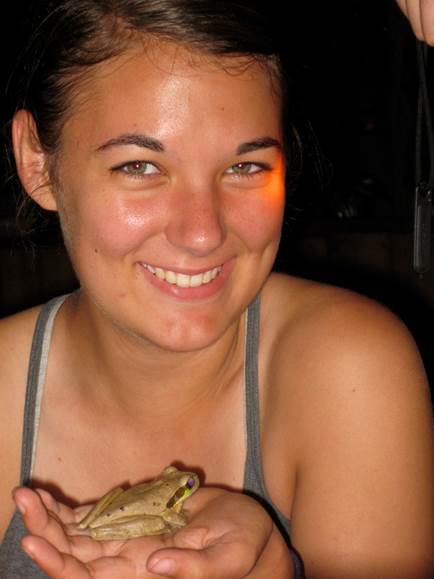
Below: our team in Costa Rica - Matt, Kristina, and Andrew Rasmussen. Andrew helped us figure out that February is the best time to visit Suriname. I'm at the bottom (which seems to be my favorite position).
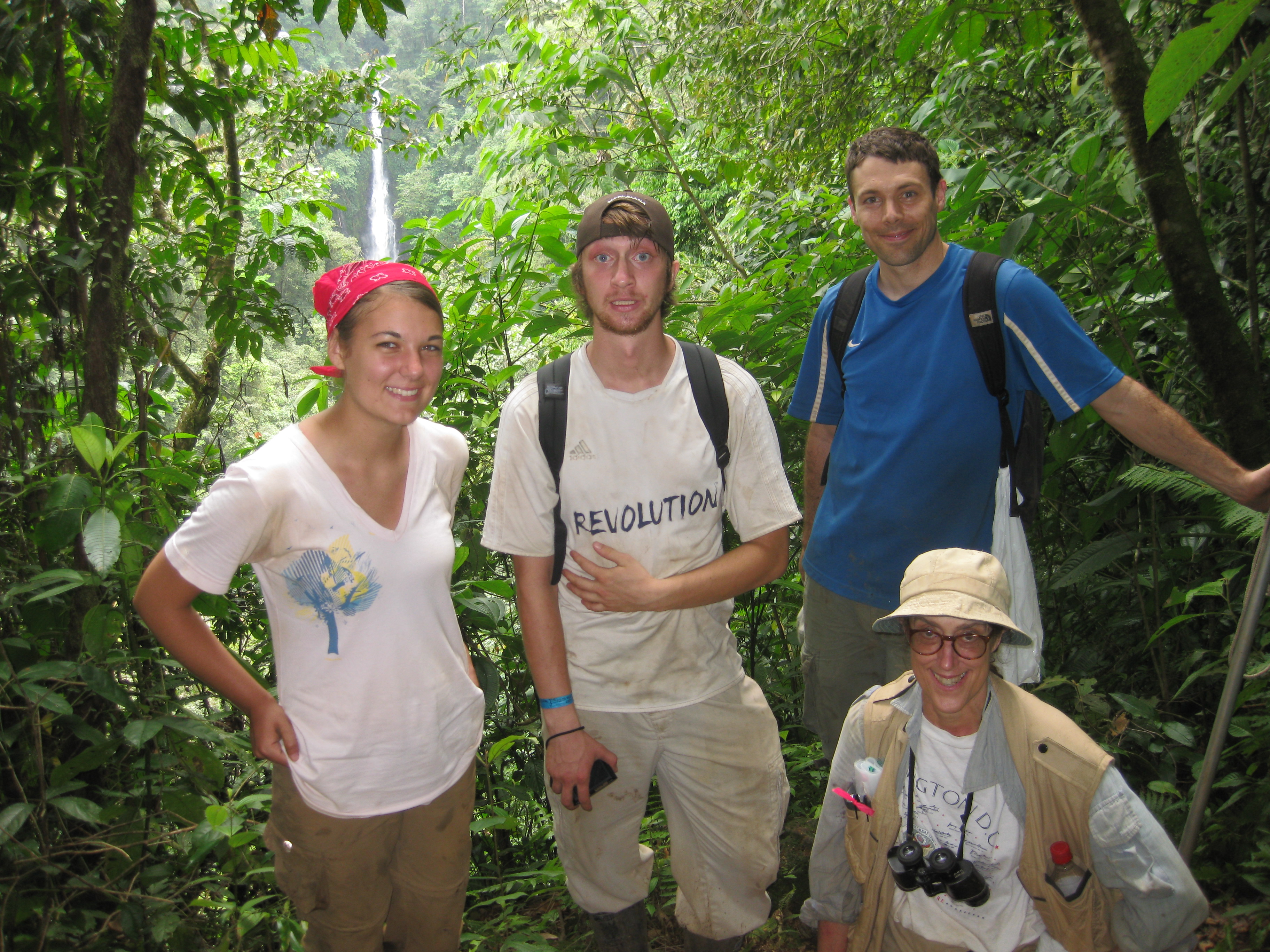
Below: SONJA SCHEFFER (far right in red T-shirt)- one of the leaders of the team- joins us at the annual Evolution meetings back in 2005- in Alaska. Sonja and I first met back in the 1990s when she was a graduate student. She discovered amazingly specialized niches of flies that feed on holly leaves. One species tunnels through the upper surface of leaves, and another species tunnels through the bottom surface of leaves. I was amazed! Her flies' specialization reminded me of our tropical flies that specialize on different sex flowers. We hit it off- and started our project together more than 10 years ago. We are at a poster presented by Sara Marsteller (Cornell College) and Darrin Bann (Ithaca College) who collaborated on a fly project. (I am at the far left- not sitting down, for a change!)

Thanks to Sonja and Matt, we have now published two papers in SCIENCE ( a journal many scientists read). Our first SCIENCE paper (2008) was featured on the cover (see below)!

This group photo (below) was taken at the annual meeting of the Entomological Society of America last year in Austin Tx where I first met Glen Hood, whose field work your donations will make possible. Glen Hood (red plaid shirt) and Andrew Forbes (far right) organized the symposium and invited scientists famous for their work on speciation: Guy Bush, Jeff Feder, Doug Futuyma and many others. Andrew Forbes provided invaluable collaboration that led to our second Science paper (2014- see media coverage). Andrew is now Kristina Ottens' advisor! (Oh yeah, per usual...I'm on the ground!)

Anielkoemar Gangadin (below) makes our work in Suriname possible. He helps us get permits and coordinates work at Brownsberg. Aniel is Assistant Curator Invertebrates National Zoological Collection of Suriname/Center for Environmental Research Anton de Kom University of Suriname
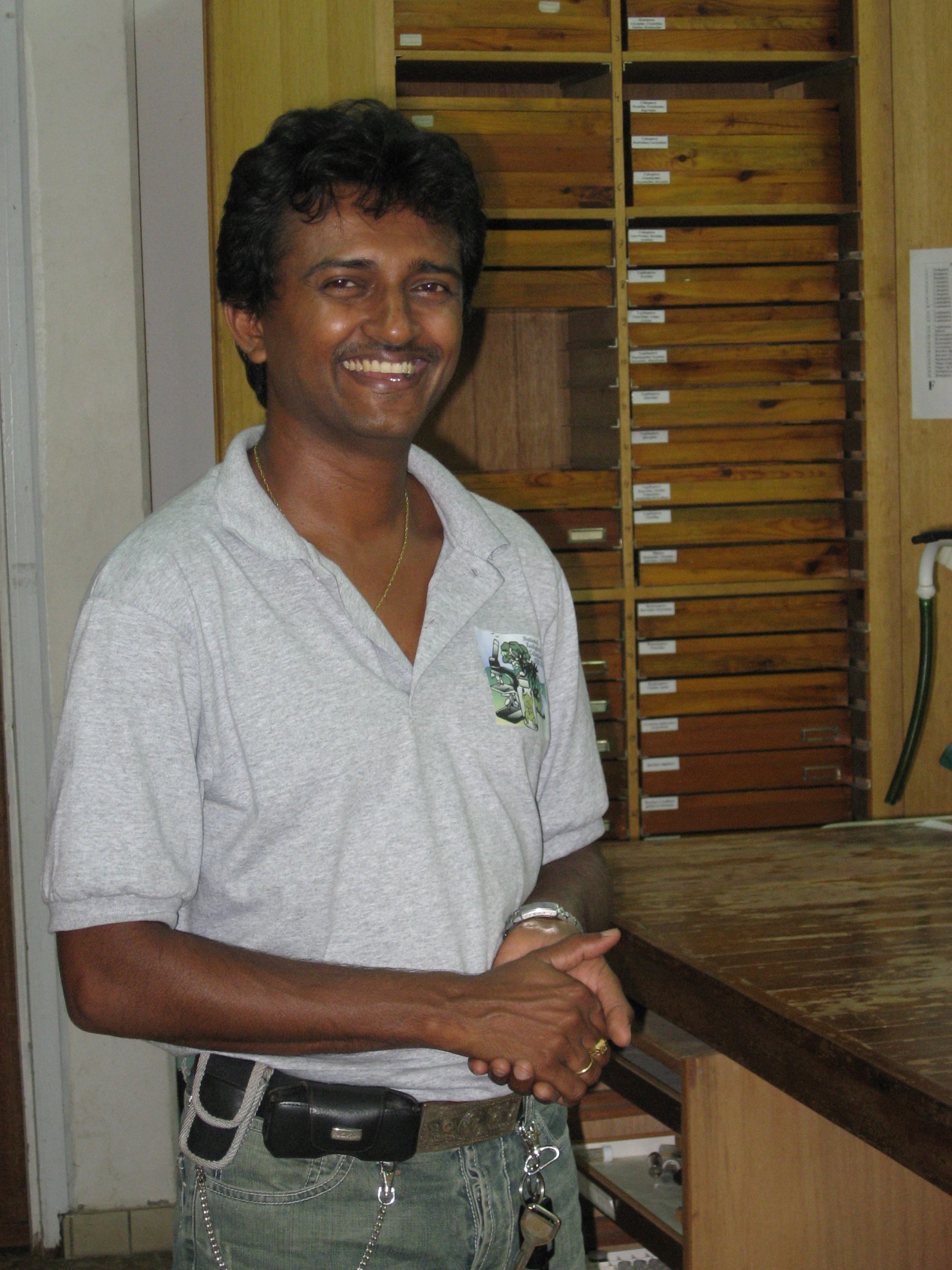
PLACE: Welcome to Brownsberg Nature Park! YOUR FUNDS we allow Kristina and Glen to go to Suriname (in northeastern South America, between Guyana and French Guiana.)

FOOD: With your support, we can EAT - but not have to cook. The cook at Brownsberg is great! Here is where we eat:
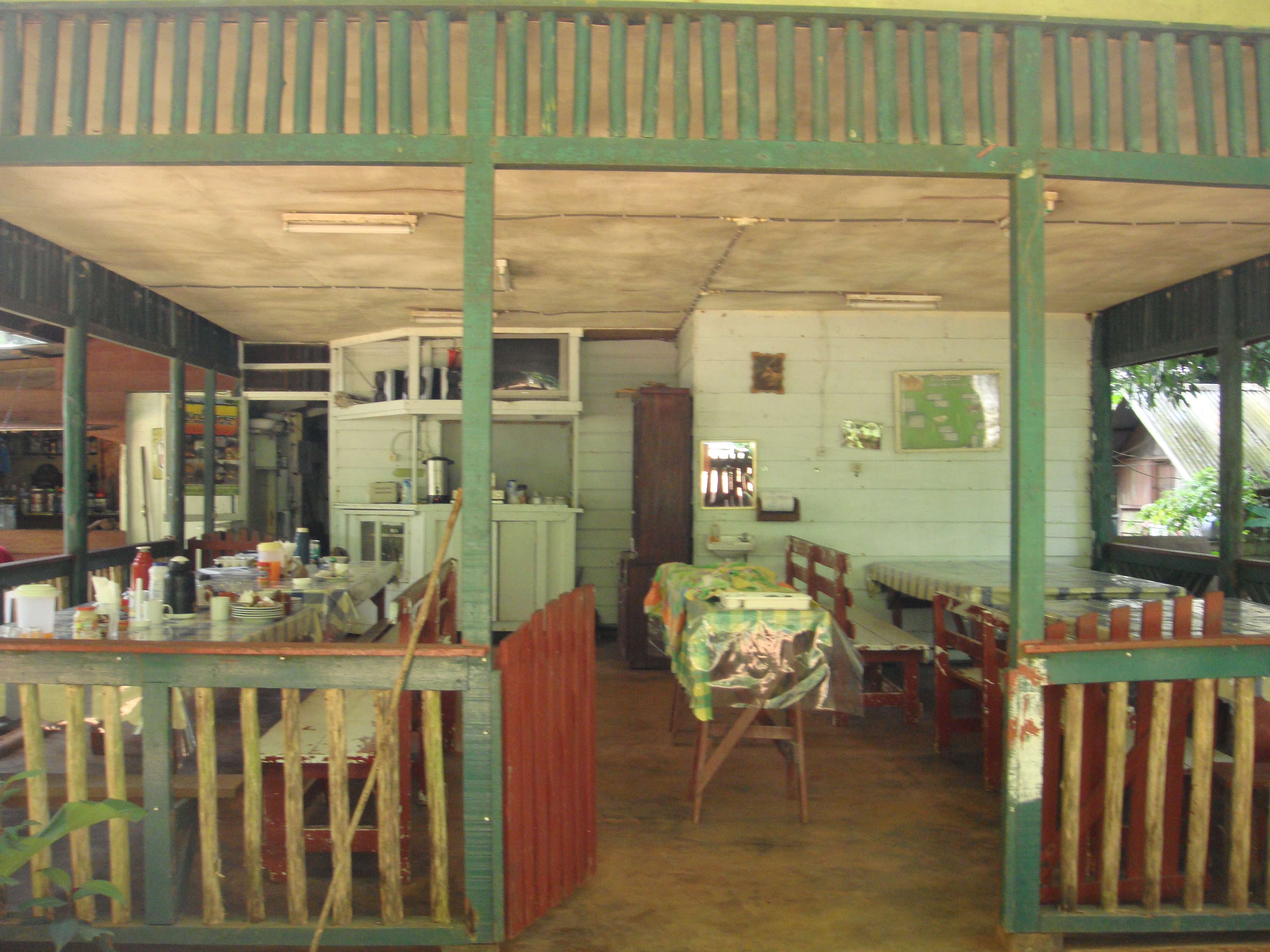
THE WORK: we will search for plants and insects in the forest- and along edges of clearings where flowers are accessible and abundant.

Here is an example of a plant that is easy to access.

And here is a picture of the edge-habitat where we often look for accessible flowers:

This is Kapasi- the "laboratory" where we sleep, sort specimens, and record data.

This is the porch of Kapasi, where we sort specimens and raise insects.

Here's the awesome view from the porch:

Here is an example of the team at work processing specimens:

Our goal: find larvae (like the one below on Andrew Rasmussen's finger) that come out of flowers.

Below is a picture of a fly larva inside a flower. Hard to see? Look in the lower right part of the green portion of the flower. The larva's mouthparts are visible as a tiny black speck.

We spend a lot of time putting flowers (and pupae) in cups. Thousands of cups. We usually take 5000 1oz plastic cups with us on each trip. Most flowers do NOT contain larvae.

When flies are finished eating, they come of out the flowers (or fruit) and pupate. Below is a photo that shows both a larva (white) and a pupa (brown), which came out of fruit collected in Mexico. We no longer put more than one fruit or flower in a cup because we want to know how many flies feed on a single plant part. Note: the "pupa" is really the hardened exoskeleton of the larva (called a "puparium". Inside that exoskeleton, the larva changes to a pupa, which - if not parasitized- will undergo metamophosis and emerge as an adult.

If the fly has been attacked by a parasitic wasp that successfully kills and eats the immature fly, then a WASP (not a fly) emerges from the puparium. See photo below, taken by Andrew Forbes, of a wasp that attacked a fly (the apple maggot) that he, Glen Hood, and Jeff Feder (among others) study.
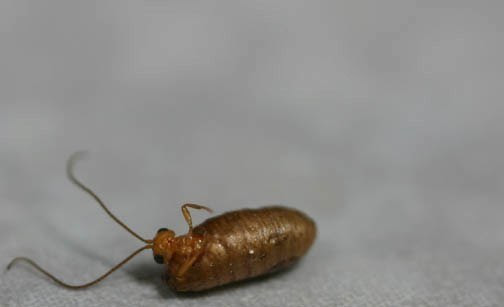
The adult wasps are beautiful. Below is a photograph taken by Akilah Stewart when she was a naturalist at Asa Wright Nature Center:

And here is one of our beautiful flies! We still have to figure out how to tell the flies apart just by looking at them. Maybe elementary school students will help us again? (See NY Times article). This photo (below) was taken by Luz Maria Huerto Santillan, who studies these flies and wasps in Peru.

Fortunately, DNA allows us to identify different species of wasps and flies- and we hope it will also help us identify viruses and bacteria that live in the insects. Below is picture of Matt Lewis in his and Sonja Scheffer's molecular lab:

WHY FLIES-- how did we get to where we are now? The story began in a beautiful forest in Venezuela where I went to study vines pollinated by Heliconius butteflies and hummingbirds. I studied the vines and associated animals there for four years!

Here is a photo of a Heliconius butterfly on Gurania subumbellata in Suriname....
and photos of hummingbirds in Venezuela at rainforest cucumbers with fruit that look like tiny watermelons:


A hummingbird (a Little Hermit) at a female flower of the most common species of rainforest cucumber. We will find this plant in Suriname!

Those hummingbird photos date back to four years (1977-1981) when I lived in a rainforest in Venezuela and collected data for my Ph.D. Initially I wanted to work on hummingbird behavior, but my interest turned to the plants. My advisor (Larry Gilbert, at the University of Texas) had evidence that the plants were very weird: more male plants than female plants-- in a surprising 9:1 ratio. I had a hunch that the plants changed sex, and that size determined gender. I was right! Small plants are male and big plants are female. I spent four years trying to figure out why. I ended up with the conclusion that the plants' gender-specific behavior sets the minimum size for females. These plants are vines. They climb for a living. But when plants turn female, they stop climbing. They hang loose. They can lose climbing ability for months (see photo of female branch and me below).
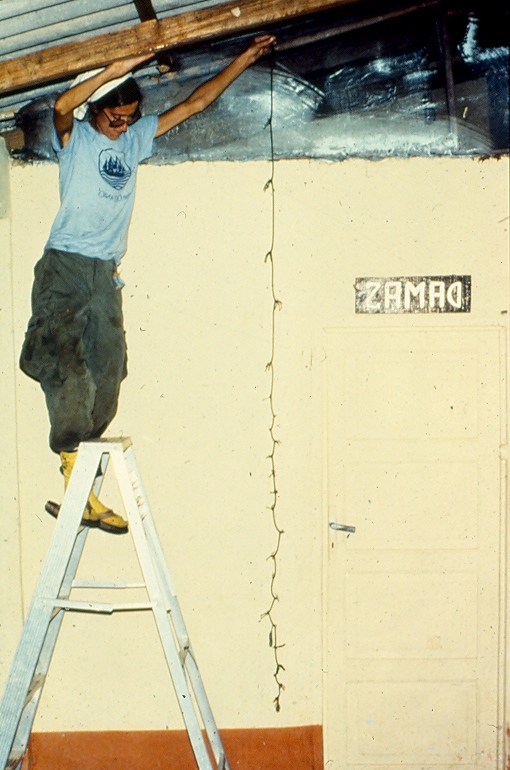
If the cost of "hanging loose" is why these vines wait so long to be female, why hang loose? The photos below give the answer:
Below is the second largest bat in South America flying toward a fruit of the sex-changing vine. Those bats disperse the seeds of the vines-- without them, the vines' babies cannot find new places to grow.

Below is a bat enjoying a fruit...while in Elizabeth Kalko's hand.

Elizabeth Kalko is in the photo below. Tragically, Elizabeth died in 2011 of unexplained causes at a field site at the base of Mount Kilamanjaro. Elizabeth was a great friend, collaborator, and scientist. In this photo she is laughing at the wax fruit we made to test the idea that bats use echos- not smell- to find fruit.

Below: a photo of the tent where Elizabeth and I did experiments to find out how bats find fruit. The bat in the photo flew to the hanging fruit, but completely ignored the ripe fruit "hidden" among leaves on the horizontal branch (bottom, far right of photo).

So... after seeing pictures of butterflies, hummingbirds and bats, you might wonder...how do FLIES fit into the picture? Well, as an evolutionary biologist, I am interested in "fitness". I wanted to know what affects the the number of surviving offspring produced by plants. Pollination is important: how many seeds result from pollination by butterflies versus hummingbirds? Seed dispersal and seed predation are also important: bats are major dispersers (good guys) and FLIES are major predators. Unfortunately, my ability to assess pollinator success (see the masking-tape labels stuck to the branch in the first hummingbird photo) was compromised: some flowers contained larvae of a fly that looked a lot like the flies that killed seeds. What were those flies? That question opened a "Pandora's Box"! I had no idea that such a basic question (who is "the fly"?) would lead to research that has kept me busy for more than 30 years!
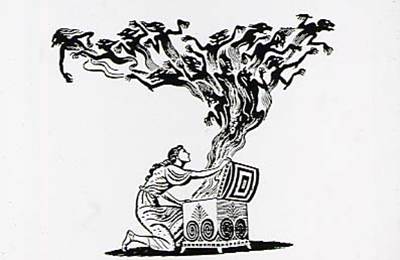
The rest, as they say, is "history". Thanks to Sonja and Matt's collaboration (and more recently, Andrew Forbes's collaboration), we published two papers in Science, both reporting results that totally surprised us. The fly story, which began with the surprising revelation that species of flies that attack flowers are different species from flies that attack fruit, led to the discovery that fly species specialize on different sex flowers-- and different species of plants. All the flies feed on plants in the squash and cucumber family. And most species of "rainforest cucumber" plants are hosts to multiple species of flies. In collaboration with botanists like Susan Swensen at Ithaca College (see center of photo below) and Gessica Costa, a Brazilian graduate student, we are still trying to figure out "who's who" among the plants. Still, it's obvious that there are many different plant species, and each is infested by different species of flies. The photo below is a team that worked at Jatun Sacha Biological Station in Ecuador, and discovered patterns (reported in 2008 in the Biological Journal of the Linnean Society) that led to the 2008 paper published in Science.

Below are photos of the wonderful Asa Wright Nature Center naturalists who raised flies in Trinidad. Left: Farah Gopaul. Center: Denise Etienne. Right: Akilah Stewart, who took the photos of the flies during various stages of development. I met Akilah, Farah, and Denise when I was on my way to Suriname to give a talk at the annual Association for Tropical Biology and Conservation meetings. In Trinidad I had 12 hours to wait for the plane to Suriname, so I decided to visit Asa Wright. Akilah, Farah and Denise saw me staring at the striped fruit next to the nature center and were curious: what was I doing? I was watching flies and wasps and was veryexcited! I told them the story, showed them how to raise flies, and left them with a supply of cups. I was thrilled when Akilah sent me these wonderful photos!

Here are Akilah's photos of:
1) fly puparium, carefully buried in moist leaves.

2) adult flies that emerged from puparia
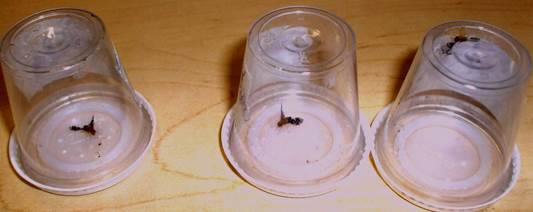
3) A nice close up photo of Akilah's fly!

Finally- here is picture of Marty with Dave Wagenheim, who joined the research team in Costa Rica when he was an undergraduate at Cornell College, where he was also captain of Cornell College's wrestling and football teams. More recently, Dave has been selling vegan hotdogs from his bicycle-powered food cart in Portland, Oregon. In this photo, Dave and Marty are standing in Nor Meyer's "bike space". Nor (who took the photo) is a compulsive collector (of bikes, not flies). He and Marty have been partners for nearly 40 years. During the summers they ride their bikes 20 miles every morning.

Family: Nor and Marty have shared their lives with many wonderful dogs. Here are Pearl and Bailey (named after jazz singer Pearl Bailey)- the newest members of the family.
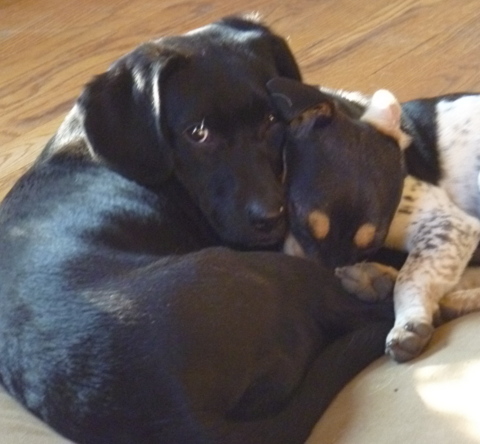
Project Backers
- 74Backers
- 150%Funded
- $3,991Total Donations
- $53.93Average Donation


